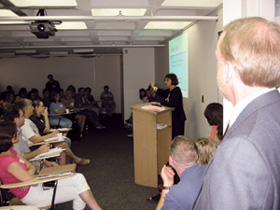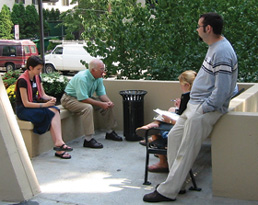SIS’ Scholarship
|
||||||
|
Larsen, who succeeded Toni Carbo as dean of Pitt’s School of Information Sciences (SIS) on July 1, 2002, has seen his work reach the moon, literally—when he worked for NASA as a programmer of real-time mission support systems for the Apollo program. He also has plumbed the depths of the oceans and explored the underwater cave systems of Florida and Mexico as a certified cave diver, logging several hundred dives to depths as great as 250 feet. In other words, Larsen would seem to be just the right kind of individual to build on SIS’ 100-year legacy and the 17-year track record of Carbo, who stepped down as dean to return to research and teaching as a professor in SIS and Pitt’s Graduate School of Public and International Affairs. “SIS has a storied history and a record of innovative
accomplishment,” said Larsen. “It is a great
school. My objective is to continue this tradition and
extend SIS’ record of accomplishment into the arena
of global information infrastructure<
The SIS history Larsen referred to began more than one hundred years ago. In 1901, the Training School for Children’s Librarians—the only school in the world at that time devoted solely to children’s librarianship—was started as a department of the Carnegie Library of Pittsburgh. Renamed the Carnegie Library School, it became part of the Carnegie Institute of Technology in 1930 and trained most of the professional librarians in the area. Carnegie Tech asked Pitt to take over the school, and, in 1962, it became known as the Graduate School of Library and Information Sciences. Today, SIS has two departments—library and information science, and information science and telecommunications—and offers an undergraduate degree in information science, three master’s degrees, four certificates of advanced study, and two Ph.D. programs. A longtime innovative leader with many programs ranked among the nation’s best (Newsweek ranks SIS’ library and information science program among the top five in the nation), SIS was the first school in the world to introduce many new technologies into its curriculum, as well as courses in information ethics and policy. In 1989, the school introduced the first information ethics forum. Medical librarianship and biomedical informatics programs were also groundbreaking efforts in the 1980s, and SIS’ telecommunications program was the first in any information sciences school. The school’s wireless and geoinformatics curricula, begun in the 1990s, keep Pitt on the leading edge of education in the information sciences to this day.
But, while Larsen appreciates the uniqueness of SIS and the challenges it presents, he hopes to build on the school’s excellence. “My objective is to help make a great school even better,” he said. “SIS has world-class programs in library and information sciences and is a pioneer in telecommunications research and education. Its information science program is highly regarded for its balance of leading-edge research and a focus on addressing the challenges facing contemporary society. “Our Visual Information Systems Center, for example, has provided significant advances for understanding geographically-based information that has found use in analysis of global economic forces and factors, and in understanding crime statistics. The center’s work is now expanding to address emerging issues in homeland security.” Larsen said he accepted the SIS deanship because he could appreciate the school’s potential. What he has found so far has exceeded even his high expectations. “The opportunities at Pitt are enormous,” he said. “When I came here, I knew SIS was a great school, but I didn’t realize the number of opportunities from which we could choose to shape its future. For example, we have had a program in medical informatics for many years, but it has been relatively small. The advances in information technologies applied in medicine and the biological sciences present huge opportunities for SIS, providing we make this a priority for the school’s future. There are other areas of similar, but perhaps less apparent, strategy. “In the days of Andrew Carnegie, the school pioneered children’s librarianship and the art of storytelling. Today, we find the principles of storytelling recurring in many of the open challenges of the emerging information society, from managing medical treatment to understanding terrorists’ motives. This information infrastructure linking individuals with the information they need is much more complex than simply a keyword search in a Web search engine, and it remains a task that is both enabled and facilitated by technology, education, and an understanding of how humans interact with each other and with the abstractions we call ‘information.’” Larsen said SIS is engaged in a strategic planning process to identify the available opportunities and to select those that truly are essential to the school’s future. “I do know, however, that many opportunities await us,” he said. “I intend to focus on information-intensive human enterprises, particularly where time is of the essence and decisions are critical. If we can expand human performance in these areas—examples include medical informatics and crisis management—then these efforts spin off to improve many other dimensions of human endeavor.” Larsen understands that whatever success SIS enjoys will be measured in a variety of ways. “Some of these measures will be quantitative, some qualitative, and some subjective,” he said. “The imploding of the telecommunications industry and the dot-com bust over the past couple of years have impacted our enrollment. Meanwhile, the nation’s need for highly trained professionals in information science has not diminished; it has, rather, shifted in response to national threats and changing opportunities. SIS needs, similarly, to adapt its programs and curriculum to these changing priorities. “Our success will be measured, first, by our ability to restore our enrollment levels and, second, by our ability to place our graduates in positions where they can contribute significantly to society’s needs in information organization, management, delivery, and utilization.” On a qualitative level, Larsen said he is committed to maintaining SIS’ nationally acknowledged level of excellence. “But our success can no longer be assured purely by internal programs and the excellence of individual faculty,” he said. “Collaboration with other schools at Pitt and with other universities in larger projects than we have pursued in the past is the key to our future. I am going to foster an environment in SIS that encourages and supports large-scale, collaborative, multidisciplinary projects.” As an example, Larsen pointed out SIS’ grant from the Pittsburgh Foundation and the Buhl Foundation, recently awarded to develop the Center for the Advancement of Libraries for Learning, a regional partnership that aims to explore and advance the role of libraries as dynamic partners in lifelong education. “And subjectively, we will measure success by how well we have created for our faculty, staff, and students an environment that fosters excellence, encourages open scholarly discourse, and supports creative endeavors. Success here may be hard to measure scientifically, but it is easily perceived through the attitudes and enthusiasm that each of us brings to our daily lives.” In other words, for those who come to teach, research, learn, or work at Pitt’s School of Information Sciences, the possibilities remain limitless. School of Information Sciences Facts Dean Ronald
L. Larsen • Year appointed
2002 • Year school
founded 1962 (with origins back to 1901)
• Location of school
Information Sciences Building, 135 N. Bellefield Ave.
• Number of students
ca. 800 • Number of
full-time faculty 31 • Number
of degree programs 6 • Number
of certificate programs 4 • Number
of alumni ca. 8,000 • Departments
within the school 2 (Library and Information
Science and Information Science and Telecommunications) |
||||||

 It’s
probably not a good idea to talk to Ron Larsen about setting
limits.
It’s
probably not a good idea to talk to Ron Larsen about setting
limits.
